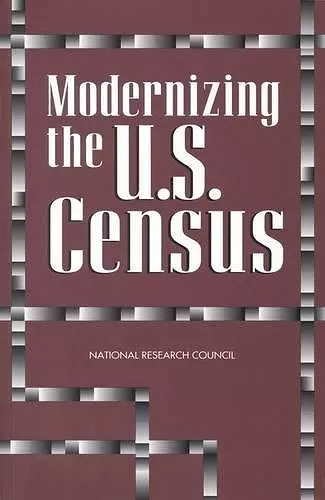Modernizing the U.S. Census
National Research Council author Division of Behavioral and Social Sciences and Education author Commission on Behavioral and Social Sciences and Education author Panel on Census Requirements in the Year 2000 and Beyond author Barry Edmonston editor Charles Schultze editor
Format:Paperback
Publisher:National Academies Press
Published:1st Feb '94
Currently unavailable, and unfortunately no date known when it will be back

The U.S. census, conducted every 10 years since 1790, faces dramatic new challenges as the country begins its third century. Critics of the 1990 census cited problems of increasingly high costs, continued racial differences in counting the population, and declining public confidence.
This volume provides a major review of the traditional U.S. census. Starting from the most basic questions of how data are used and whether they are needed, the volume examines the data that future censuses should provide. It evaluates several radical proposals that have been made for changing the census, as well as other proposals for redesigning the year 2000 census. The book also considers in detail the much-criticized long form, the role of race and ethnic data, and the need for and ways to obtain small-area data between censuses.
Table of Contents- Front Matter
- SUMMARY
- 1 THE ROLE OF THE CENSUS
- 2 POPULATION COVERAGE AND ITS IMPLICATIONS
- 3 CENSUS COST INCREASES AND THEIR CAUSES
- 4 RADICAL ALTERNATIVES
- 5 A REDESIGNED CENSUS
- 6 CENSUS CONTENT
- 7 DATA ON RACE AND ETHNICITY
- 8 INTERCENSAL SMALL-AREA DATA
- REFERENCES
- APPENDICES
- A Basic Information on Census Questionnaires
- B The Census Process
- C Data Requirements for Reapportionment and Redistricting
- D Research Uses of Census Data
- E State and Local Needs for Census Data
- F Business Uses of Census Data
- G Use of Decennial Census Data in Transportation Planning
- H Census Data Needs for Housing and Urban Development
- I Alternative Ways to Produce Intercensal Small-Area Data
- J Content and Quality of Federal and State Administrative Records
- K Quality of Current Data on Race and Ethnicity
- L Allocation Rates
- M Census Data Requirements by Federal Agencies
- N Groups and Individuals Consulted
- O Biographical Sketches <
ISBN: 9780309051828
Dimensions: unknown
Weight: unknown
480 pages